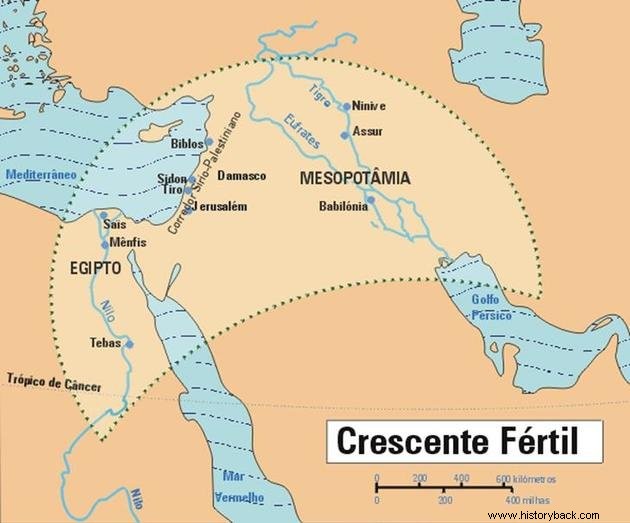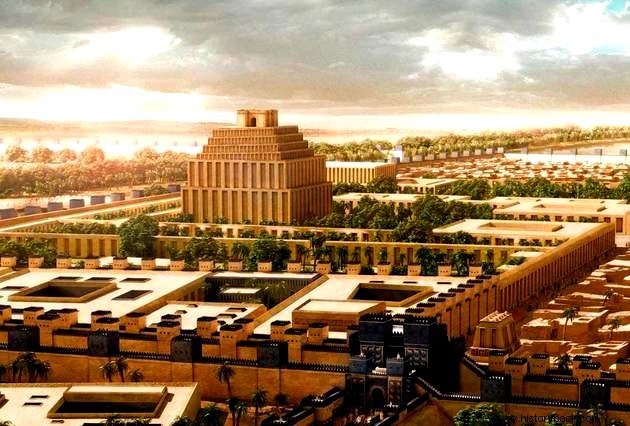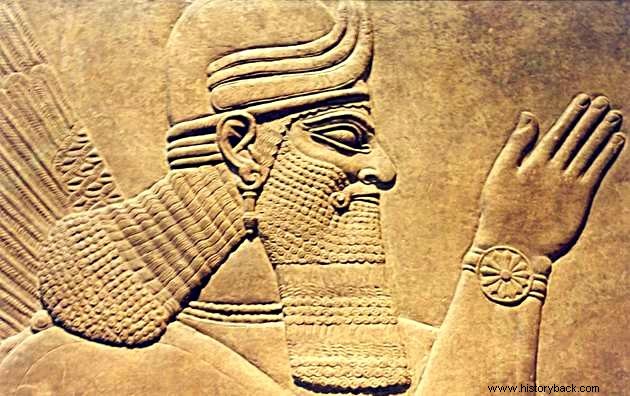The Mesopotamian civilization developed in the valley of the Tigris and Euphrates rivers and is considered the cradle of western culture.
From those peoples come astronomical calculations, writing, the first code, city-states and much more.
Mesopotamia was a fertile region that facilitated the settlement of populations. In successive times, Sumerians, Akkadians and Assyrians, among other peoples, dominated this area.
Origin of Mesopotamian Civilization

The word "Mesopotamia" comes from the Greek and means "between two rivers". With the abundance of water and fertile lands, the first human beings decided to settle there, between the Tigris and Euphrates rivers, in a phenomenon known as the Urban Revolution.
Cities were protected by walls and their tallest buildings were temples, called ziggurats . These were administered by priests who held the administrative power of the city.
Over time, these cities grew and aroused the greed of the neighbors. There was a need to separate religious and administrative power and the first military commanders appeared.
Not everything, however, was resolved with struggles. Cities also started to sell what they didn't need (surpluses) and this generated the first commercial exchanges that are known.
See also:Fertile CrescentPeoples of Mesopotamia:Sumerians and Akkadians
Sumerians
The first civilization that developed in Mesopotamia was that of the Sumerians, a people from the neighboring plateau of Iran.
Quish would have been the first city of this civilization, then Ur, Uruk, Nipur, Lagash, Eridu and Nippur appeared.
Each city was independent, governed by a patesis , mixture of military chief and priest. They controlled the population, collecting taxes and managing the works to store the water that would be used in times of drought.
The lands were considered the property of the gods, and it was up to man to serve them, not only with agricultural work, but also with the edification of the zigurates .
The Sumerians developed a system of law based on custom and were skilled in commercial practices. That's why they developed cuneiform writing, so called because it was made with a wedge-shaped stylus that they carved into clay tablets.
See also:SumeriansAkkadians
After a long time of autonomy, Sumerian cities weakened due to struggles for political hegemony.
The weakening made it possible for several Semitic peoples to invade - peoples of Southeast Asia who spoke Semitic languages such as Hebrews, Arabs, Ethiopians, Babylonians, Assyrians, Arameans, Canaanites and Phoenicians.
Its most important city was Acad, which gave rise to the term Akkadians . Around 2330 BC, the Akkadian king Sargon I unified the Sumerian cities, creating the first recorded empire in history, the Akkadian Empire.
However, continuous foreign invasions made the permanence of this domain unfeasible, which ended up disappearing around 2100 BC.
See also:AkkadiansFirst Babylonian Empire (1800-1600 BC)

Among the invaders from Mesopotamia who overthrew the Akkadians were the Amorites , from the Arabian desert. The Amorites settled in the city of Babylon in Middle Mesopotamia.
Around the 18th century BC, Hammurabi, king of Babylon, managed to unify the entire region by founding the First Babylonian Empire.
The city became one of the largest urban centers in antiquity, where important architectural monuments were built.
This is the case of the ziggurat of Babel, cited in the Bible as the tower built to reach heaven.
See also:AntiquityCode of Hammurabi and Mesopotamian Civilization
Hammurabi, the most important king of Babylon, organized the first code of written laws - Code of Hammurabi. For the sovereign, if the laws were engraved, everyone could obey them anywhere in the kingdom.
In this way, the Code presented a series of penalties for crimes in all spheres of life, whether domestic or professional, in relation to the ownership of real estate and slaves. The prescribed punishments varied according to the social status of the victim and the offender.
The Code of Hammurabi may seem cruel to us today, but it was intended to regulate revenge. The Law of Talion was extracted from him, which preached the principle of "an eye for an eye, a tooth for a tooth".
However, we must understand that the society for which it was created did not have the notion of a constituted Law and, in theory, anyone could take justice into their own hands.
See also:Babylonian EmpireCharacteristics of the Peoples of Mesopotamia

Despite the great cultural diversity, some characteristics were common to the different societies that developed in Mesopotamia.
Economy
The basis of the economy was agriculture, which depended on the floods of the Tigris and Euphrates rivers. The monetary system was poorly developed, but barley and metals were used as a reference for value.
Society
Free people predominated in the region. Slaves emerged during wars and belonged to the community. They were used in the toughest jobs, like mines.
See also:Peoples of MesopotamiaReligion
Mesopotamian peoples were polytheists.
Each people worshiped a deity more intensely:the Babylonians, Marduk; the Assyrians, Asshur. A very popular goddess was Ishtar, protector of fertility, life, beauty and love.
See also:PaganismScience and Culture
The Mesopotamian peoples excelled in science, architecture, and literature. By observing the sky, the priests developed the principles of astronomy and astrology.
The ziggurats, temples that housed granaries and workshops, were also true observation towers of the heavens. They described calculations of the motion of planets and stars and the elaboration of sophisticated calendars.
It was the Mesopotamians who created the calendar by dividing the year into 12 months and the week into seven days, each into 12-hour periods.
They also developed algebraic calculations, divided the circle into 360 degrees and calculated the square and cube roots. In architecture, they introduced the use of arches and bas-relief decoration.
In literature, they created poems and epic narratives, such as the Epic of Gilgamesh, which inspired the description of the biblical flood.
See also:History and Origin of the CalendarCuriosities
- In Babylon was situated one of the Seven Wonders of the Ancient World, the Hanging Gardens.
- Most of the territory of ancient Mesopotamia is currently located in Iraq and Iran.
We have more texts on the subject for you :
- Mesopotamian Art
- Questions about Mesopotamia
